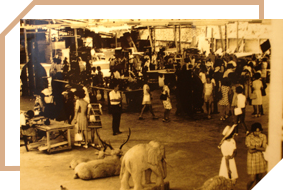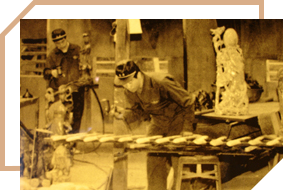The Beginning Natural Wood Decoration

Sanyi is situated in a mountainous area with very little fertile land, but the acid clay of the hills is suitable for cultivation of camphor trees and tea trees. Before Taiwan was ceded to Japan after the First Sino-Japanese War, the hills in Sanyi were covered with original camphor forest. During the Japanese occupation of Taiwan, the Japanese cut down camphor trees for medical and industrial purpose. When camphor trees were deforested, workers were hired to grow tea trees. Our early ancestors living in Sanyi were hired by the Japanese to plant tea trees, and they accidentally discovered roots of chopped camphor trees buried deep underground. The roots were partly eaten away by termites, but once excavated and cleaned, they became natural wood of high decorative value. These natural woods are thus considered nature’s works of art.
Of course, not all natural wood can become artwork without any help. Skilled sculptors usually use the original shape as the base to start carving and carve new life into the wood. This is how wood carving in Sanyi becomes so well-known in the world.
The most well-known sculptor in Sanyi is Liou Yi-chun. Born in 1915 into a well-to-do family, Liu was neither an artist nor a traditional craftsman. He became the pioneer of industrial art during the Japanese colonial period by accident. That year, the winter was freezing cold, and Liu was trying to find a utensil for heating purpose. When he looked around, he noticed an old wood mortar sitting in the corner. The wood mortar was a utensil made by digging a hole in a big piece of wood and the tool was used to grind steamed sticky rice. Having been used for a long time, the old wood mortar looked like wrinkles on the face of an old man, with a sense of affability. Liu had an idea to place a copper sheet on the hole and add some charcoal, which turned the old wood mortar into a hibachi.
The news quickly spread across the island and when the Japanese living in Taiwan heard the news, they came to invite Liu to join their company. They collected abandoned wood mortars and transformed these wood mortars into hibachi to export to Japan. This was the first example of export of practical art. As the winter in Japan can be freezing, the artwork with both decorative and practical value was extremely popular in Japan. Liu was able to earn a lot of money, which laid the foundation for the miracle of wood carving in Sanyi after Taiwan was restored.
Taiwan was restored in 1945 and Singye Enterprise (also known as Baiji Store) was established in the following year to sell wood carving. Unfortunately, in 1947, the February 28th Incident occurred, which shocked the whole world. Taiwan was severely damaged during the Japanese colonial period and the Second World War and the slight chance of recovery after restoration of Taiwan was destroyed by February 28th Incident. It was really difficult for wood carving industry in Sanyi to prosper.

Then, in 1950, when the Korean War broke out, the United States sent its troops to station in Taichung, Taiwan, which was only 30 minutes away from Sanyi. American soldiers often came to Sanyi for their vacation and they would buy some wood carving works as gifts for their families in the US. This was the beginning of wood carving in Sanyi.
However, Sanyi still lagged behind Lugang of Changhua County, Dasi of Taoyuan County, Wanhua of Taipei City, Tainan City, Hsinchu City and the neighboring Tongyu and Fongyuan. For instance, there was no wood carving shops for religious statues in Sanyi, but these shops were quite common in all the other areas. Craftsmen in these areas would teach their apprentices how to carve religious statues, statues, flower and birds for temples. Usually, the apprentices would need to work under the master for more than 3 years and 4 months and they can only become craftsmen themselves once their teachers believed that they were qualified, so they could become fine sculptors in carving religious statutes and other sculptures. On the other hand, in Sanyi area, craftsmen, wood carving workers and anyone who were strong and knew how to use hoe or broach could be hired by stores and shops to make wood cutty, ashtray, fruit plate, candy tray, flower bed and chairs. This was quite different from the traditional mentoring.
